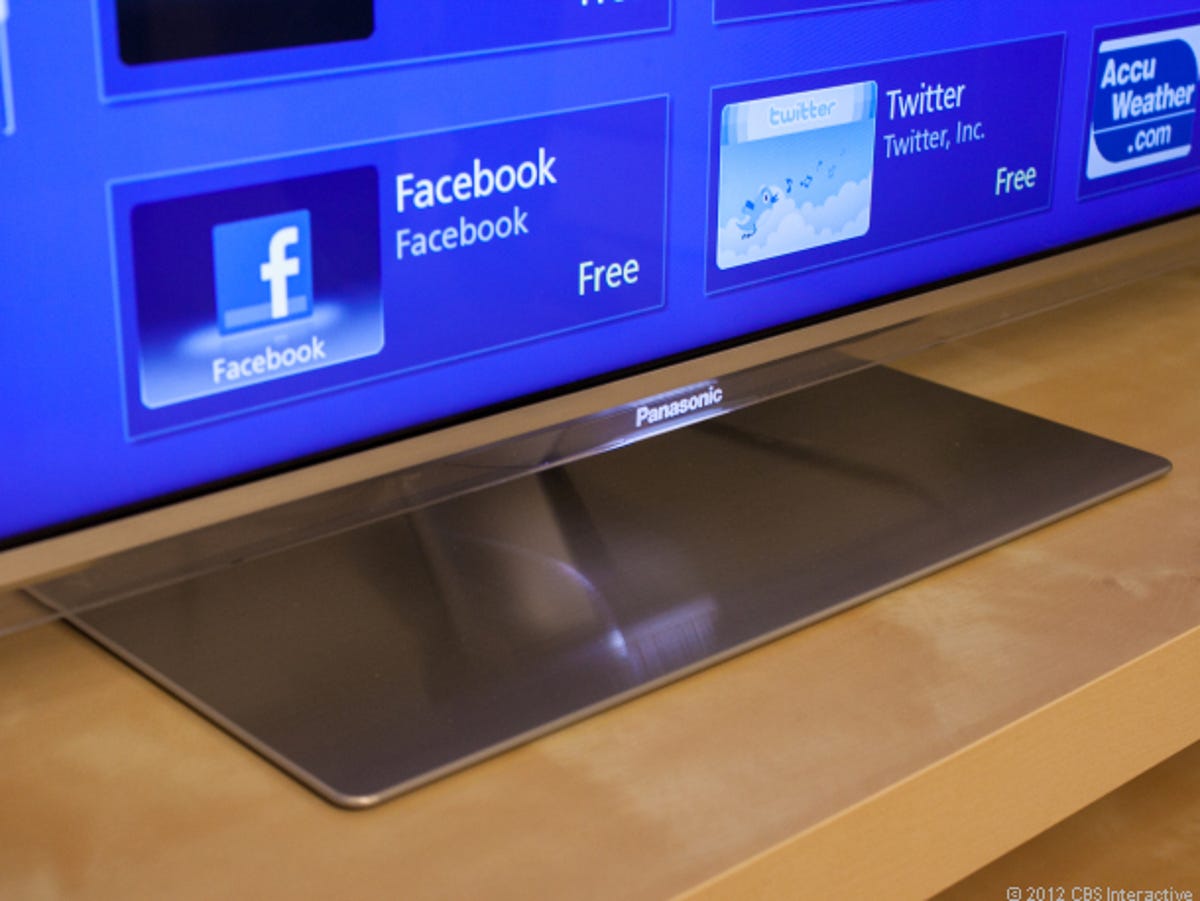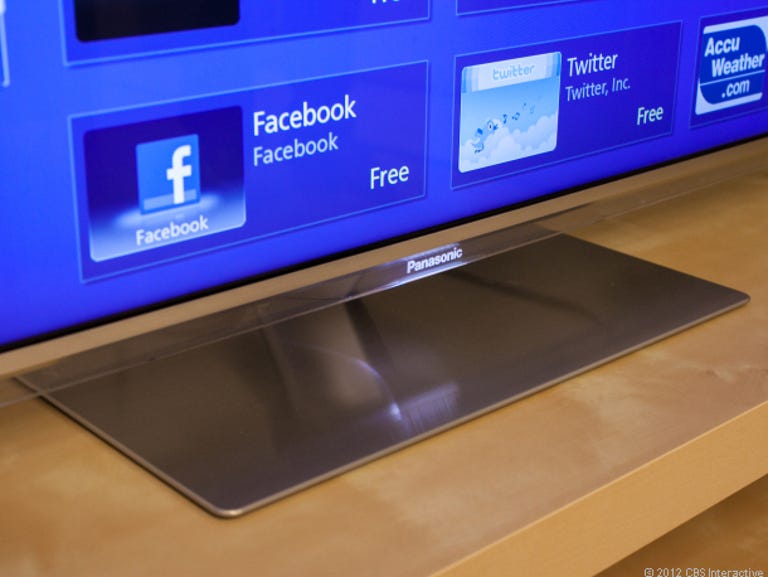 Why You Can Trust CNET
Why You Can Trust CNET Panasonic TC-LDT50 review: Panasonic TC-LDT50
Panasonic TC-LDT50
One of my favorite reviews of all time was for a David Lee Roth solo record from the 90's called "A Little Ain't Enough." In reference to the title, and the quality of the record, the music reviewer replied with just two words. Just two. Unfortunately there cannot just be a single, pithy one-liner for the Panasonic DT50 LCD TV, but it can't be all that bad, right? My words, as were the Rolling Stone reviewer's at the time, are: "Wanna bet?"
The Good
The Bad
The Bottom Line
Panasonic offers LCD TVs in order to appeal to plasma-phobes, but for a TV as expensive and poorly performing as the DT50, I've got to wonder if the effort is worth it. The DT50 is plagued by poor black levels and an uneven color response, which makes it difficult to watch in a dark room. Conversely, its glossy screen means that in a well-lit room it's too reflective to enjoy completely.
On the upside the TV does come with a full complement of video apps, and the 3D performance is better than our current 2D star, the (plasma)
Series information: I performed a hands-on evaluation of the 47-inch Panasonic TC-L47DT50, but this review also applies to the other screen size in the series (55-inch). Both sizes have identical specs and according to the manufacturer should provide very similar picture quality.
| Models in series (details) | ||||
| Panasonic TC-L47DT50 (reviewed) | 47 inches | |||
| Panasonic TC-L55DT50 | 55 inches | |||
Design
Up until 2012, design was never a major consideration for Panasonic, a company much more concerned with picture quality than aesthetics. But the outlook has brightened, and this year's Panasonic crop is keeping an eye to a more modern design aesthetic -- even if it's still a couple of years behind. For example: the ST50 looks like any number of Samsung/LGs from the last couple of years and the VT50 looks like an iPod touch. The DT50 goes even further back with a bezel design reminiscent of the "floating glass" Sony televisions of 2004. The Panasonic's aluminum bezel is impressively thin however and subtler than the similar-looking LG G2.
Panasonic's yellow-on-blue menus haven't changed and remain a bit archaic-looking if easy enough to use. The remote control is also largely untouched, with just a lick of gloss paint and an Internet (Viera/Smart/Connect) button to differentiate it from previous models. But why ruin a good thing?

| Key TV features | ||||
| Display technology | LCD | LED backlight | Edge-lit | |
| Screen finish | Glossy | Remote | Standard | |
| Smart TV | Yes | Internet connection | Wireless | |
| 3D technology | Active | 3D glasses included | No | |
| Refresh rate(s) | 240Hz | Dejudder (smooth) processing | Yes | |
| DLNA compliant | Photo/Music/Video | USB | Photo/Music/Video | |
| Other:None | ||||
Features
The DT50 is an LED edge-lit LCD with a 240Hz panel; ignore the "backlight scanning 1920" marketing bunk. 3D glasses aren't included, but thankfully it's compatible with the universal standard so you can use compatible 2012 glasses like the Samsungs ($20 each) instead of the Panasonics ($60). The DT50, along with all 2012 Panasonic TVs, won't work with 2011 or earlier glasses.
Some people may also appreciate the 2D-3D conversion capability but I personally prefer to watch 3D native content, as it leads to less eyestrain. The TV offers a number of wireless functions including its Smart Viera platform and offers smartphone control and third-party gaming control support.
Smart TV: Panasonic debuted its Smart TV platform several years ago and the name has changed a few times -- now it's called Smart Viera. The interface remains the same, though, and it's still easy to use. It consists of a big a grid of eight tiles with all of the best apps available on the first screen, including Hulu Plus, Netflix and Skype. You can swap any available app in or out, a level of customization not found on other Smart TV suites. Response is a bit sluggish and the look somewhat old-fashioned compared to the slick interfaces of LG and Samsung, but it's also arguably more usable.
Update: The latest software update causes the TV to show you a banner ad when you first power up. It popped up and lasted about 3 seconds, but it was still annoying. I was happy to see I could disable it (here's how), but the banner is turned on by default.
Picture settings: Despite the high price, the Panasonic gives you only a basic selection of picture controls, so its poor red/blue balance, for example, is unable to be corrected. Setting the DT50 to Cinema mode is probably about as good as you'll get out of this TV unless you pay for a service menu calibration. In regard to 3D, the TV does offer a couple of extra controls for 3D depth.
Connectivity
At its price level we'd expect onboard wireless, which Panasonic provides, plus the TV's got the obligatory four HDMI inputs and two USBs. Interestingly it also features a Bluetooth module for use with the 2012 glasses. Check the Specifications section for a full list of inputs and outputs.
Picture quality
I'll start with what I liked about the DT50. Let's see now...3D is good for an LCD at this level, which isn't to say it has the crosstalk-free edges of LG's passive system, but it is better than most 2011 active LCDs for crosstalk. Processing is also good with rock-solid 24p support and an excellent ability to banish jaggies from 1080i content.
The negatives far outweigh the positives, however. I'll touch on the black levels in depth shortly, but poor uniformity means that whatever blacks are there are mottled as well. Of our lineup of five TVs, the DT50 had the worst overall picture -- worse than the ultrabudget
Click the image at the right to see the picture settings used in the review and to read more about how this TV’s picture controls worked during calibration.
| Comparison models (details) | ||||
| TCL L40FHDF12TA | 40-inch LCD | |||
| Sony KDL-55HX750 | 55 inch edge-lit LCD | |||
| LG G2 | 47-inch edge-lit LCD | |||
| Panasonic TC-P55ST50 | 55-inch, plasma | |||
| Samsung UN46D6400 | 46 inch, LCD | |||
| Samsung PN59D7000 (reference) | 59 inch plasma | |||
Black level:
Simply put, the Panasonic DT50 had the lightest blacks in our lineup, which made its image look more washed out and lifeless in comparison. It suffers a lack of contrast so whites don't pop the way they do on competing TVs like the
Properly adjusted, there was very little shadow detail on the Panasonic, just an ashen mush that leaves three-dimensional objects -- with light and shade and shape -- looking almost like shadow puppets. On the other hand, the AI Picture setting does go some way toward enhancing shadow detail, but it does so unnaturally in comparison with our test TVs. It makes objects look even lighter than they really are.
Color accuracy:
A lack of fine color control means you get what the TV gives you out of the box, and this is not much. The color response is a seesaw with the heaviest color at one end being blue (blue shadows) and the lighter color dangling at the top being red (rosy skin tones). I experimented with the color control between a value of 44 (which looked the most natural) and 57 (which made the response graphs pretty, but the picture looked weird) and decided ultimately to leave it at the original. When viewed against a better TV such as the ST50, the LCD's lack of saturation is instantly noticeable. Color response is simply another thing this TV does poorly.
Video processing:
For a long time Panasonic lagged against competitors such as Sony in terms of video processing capabilities with jaggies and judder commonplace. About two years ago Panasonic caught up, and the DT50 at least bears this hallmark. On our 24p test the TV was able to smoothly replay a flyby of an aircraft carrier, and 1080i film playback was also finely resolved.
Uniformity:
Uniformity is another area where this edge-lit TV falls apart, with large blotches across the right-hand side on the model I received. It may not have had the oil-slick appearance of the LG G2 but it was definitely more noticeable on the majority of content. At a preview some months ago Panasonic claimed the viewing angle of the DT50 was very wide and with the bright demo screens it was. But with normal, non-glaring colors the viewing angle is no better than most other TVs of its type with de-saturated blacks when viewed from the side.
Bright lighting:
The DT50 has a glossy coating, which is a trick usually employed on LCD screens to preserve black levels when seen under lights. But the gloss has a side effect: you can see yourself reflected in it during a dark scene. For brighter rooms we'd pick a TV that has a more matte finish, such as the HX750.
3D:
That the Panasonic DT50 performs better than the ST50 in 3D mode is the only surprise here. Throw on a pair of (optional) 3D glasses and the DT50 displays considerably less crosstalk than either the ST50 or the Sony HX750. The lack of black levels did mean that the image wasn't as believeable as that on the LG G2 or Samsung 6400, though. The extra cost of Panasonic's glasses is also an inhibiting factor.
| Test | Result | Score |
|---|---|---|
| Black luminance (0%) | 0.2397 | Poor |
| Avg. gamma | 2.2019 | Good |
| Near-black x/y (5%) | 0.2695/0.2723 | Poor |
| Dark gray x/y (20%) | 0.3058/0.3192 | Poor |
| Bright gray x/y (70%) | 0.315/0.3325 | Average |
| Before avg. color temp. | 6423.1051 | Good |
| After avg. color temp. | 6424.25 | Good |
| Red lum. error (de94_L) | 12.719 | Poor |
| Green lum. error (de94_L) | 6.6127 | Poor |
| Blue lum. error (de94_L) | 9.174 | Poor |
| Cyan hue x/y | 0.2262/0.3147 | Average |
| Magenta hue x/y | 0.3024/0.1516 | Poor |
| Yellow hue x/y | 0.4331/0.5065 | Average |
| 1080p/24 Cadence (IAL) | Pass | Poor |
| 1080i Deinterlacing (film) | Pass | Good |
| Motion resolution (max) | 1200 | Good |
| Motion resolution (dejudder off) | 350 | Poor |
| PC input resolution (VGA) | 1,920x1,080 | Good |



